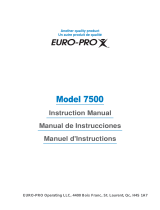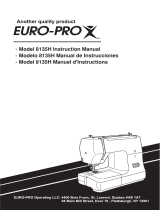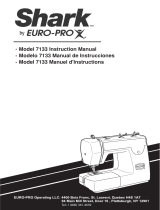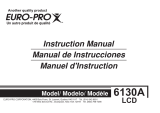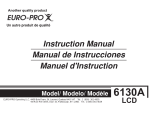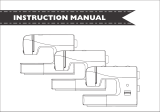Page is loading ...

Manual
7535
EURO-PRO Operating LLC, 4400 Bois Franc, St. Laurent, Quebec H4S 1A7 Tel. 1 (800) 361-4639
21 Lawrence Paquette Industrial Drive, Champlain, New York 12919 Tel. 1 (800) 361-4639

When using an electrical appliance, basic safety precautions
should always be followed, including the following:
Read all instructions before using this sewing machine.
1. An appliance should never be left unattended when plugged in.
2. Always unplug this appliance from the electric outlet
immediately after using and before cleaning.
3. Always unplug before relamping. Replace bulb with same
type rated 10 watts (110-120V area) or 15 watts (220-240V
area).
1. Do not allow to be used as a toy. Close attention is necessary
when this appliance is used by or near children.
2. Use this appliance only for its intended use as described in
this manual. Use only attachments recommended by the
manufacturer as contained in this manual.
3. Never operate this appliance if it has a damaged cord or plug,
if it is not working properly, if it has been dropped or
damaged, or dropped into water. Return the appliance to the
nearest authorized dealer or service center for examination,
repair, electrical or mechanical adjustment.
4. Never operate the appliance with any air openings block.
Keep ventilation openings of the sewing machine and foot
controller free from accumulation of lint, dust, and loose cloth.
5. Keep fingers away from all moving parts. Special care is
required around the sewing machine needle.
6. Always use the proper needle plate. The wrong plate can
cause the needle to break.
7. Do not use bent needles.
8. Do not pull or push fabric while stitching. It may deflect the
needle causing it to break.
9. Switch the sewing machine off ("O") when making any
adjustments in the needle area, such as threading needle,
changing needle, threading bobbin, or changing presser foot,
and the like.
10.Always unplug sewing machine from the electrical outlet when
removing covers, lubricating, or when making any other user
servicing adjustments mentioned in the instruction manual.
11.Never drop or insert any object into any opening.
12.Do not use outdoors.
13.Do not operate where aerosol spray products are being used
or where oxygen is being administered.
14.To disconnect, turn all controls to the off ("O") position, then
remove plug from outlet.
15.Do not unplug by pulling on cord. To unplug, grasp the plug,
not the cord.
This sewing machine is intended for household use only.
DANGER
SAVE THESE INSTRUCTIONS
- To reduce the risk of electric shock:
WARNING - To reduce the risk of burns, fire,
electric shock, or injury to persons:
IMPORTANT SAFETY INSTRUCTIONS

Congratulations:
As the owner of a new sewing machine, you will
enjoy precision quality stitching on all types of fabrics, from
multiple layers of denim to delicate silks.
Your sewing machine offers the ultimate in
simplicity and ease of operation. For your safety and to fully
enjoy the many advantages and ease of operation of your
sewing machine, we recommend that you read all the
important safeguards and use and care instructions in this
instruction book.
May we suggest that before you start to use your sewing
machine, you discover the many features and advantages by
going through this instruction book, step by step, while seated
at your sewing machine.
EURO-PRO
EURO-PRO
EURO-PRO
EURO-PRO
Félicitations:
A titre de nouveau propriétaire d'une machine à coudre
, vous pourrez apprécier une couture de qualité
sur tous les genres de tissus, que ce soit plusieurs
épaisseurs de denim ou de la soie délicate.
Votre machine à coudre offre ce qu'ilyade
mieux en fait de simplicité et de facilité d'usage. Pour votre
sécurité et afin de pleinement apprécier les nombreux
avantages de votre machine à coudre, nous recommandons
que vous lisiez toutes les mesures de sécurité et les
instructions qui sont contenues dans le présent manuel.
Permettez-nous de vous suggérer, avant d'utiliser votre
machine à coudre, de découvrir les nombreuses
caractéristiques et avantages en feuilletant ce manuel, étape
par étape, assise face à votre machine à coudre.

List of contents
Sommaire
Principal parts...............................................................................................2/3
Accessories .....................................................................................................4
Fitting the snap-in sewing table.......................................................................5
Connecting machine to power source .............................................................6
Changing the bulb ...........................................................................................8
Two-step presser foot lever/ Adjusting the presser foot pressure ...................9
Attaching the presser foot holder ..................................................................10
Winding the bobbin........................................................................................12
Inserting bobbin.............................................................................................13
Changing the needle (System 130/705H) .....................................................14
Threading the upper thread...........................................................................15
Thread tension ..............................................................................................16
Bringing up the lower thread .........................................................................17
Reverse sewing/ Changing sewing directions...............................................18
Removing the work/ Cutting the thread .........................................................19
Matching needle / fabric / thread ...................................................................20
How to choose your pattern ..........................................................................22
Straight stitching and needle position............................................................23
Zig zag sewing ..............................................................................................24
Blind hem/ lingerie stitch ...............................................................................25
Overlock stitches ...........................................................................................26
Sewing on buttons.........................................................................................27
How to sew buttonholes ................................................................................28
Zippers and piping.........................................................................................30
Sewing with the hemmer foot ........................................................................31
3-step zig-zag................................................................................................32
Stitch selection ..............................................................................................34
Smocking stitch .............................................................................................35
Sewing with the cording foot .........................................................................36
Free motion darning ......................................................................................37
Practical stitches ...........................................................................................38
Darning..........................................................................................................40
Attaching lace................................................................................................41
Applique ........................................................................................................42
Twin needle ...................................................................................................43
Monogramming and embroidering with embroidery hoop*............................44
Monogramming and embroidering (continued) .............................................45
Quilting ..........................................................................................................46
Gathering.......................................................................................................47
Scallop stitching ............................................................................................48
Patch work.....................................................................................................49
Maintenance..................................................................................................50
Trouble shooting guide..................................................................................52
Pièces principales de la machine .................................................................2/3
Accessoires .....................................................................................................4
Mise en place de la table-rallonge...................................................................5
Branchement de la machine à coudre.............................................................7
Changement de l'ampoule...............................................................................8
Levier du pied-de-biche à deux positions/
Ajustement de la pression du pied-de-biche ..............................................9
Montage du support du pied-de-biche...........................................................11
Remplir la canette .........................................................................................12
Mise en place de la canette...........................................................................13
Mise en place de l'aiguille (Système 130/705H)............................................14
Enfilage du fil supérieur.................................................................................15
Tension du fil .................................................................................................16
Remonter le fil inférieur .................................................................................17
Marche arrière/ Pour modifier le sens de la couture .....................................18
Retrait de l'ouvrage/ Couper les fils...............................................................19
Tableau des aiguilles et fils ...........................................................................21
Sélection des points ......................................................................................22
Couture au point droit et position d'aiguille....................................................23
Couture au point zig-zag ...............................................................................24
Ourlet au point invisible .................................................................................25
Point overlock................................................................................................26
Pose des boutons..........................................................................................27
Faire les boutonnières...................................................................................29
Pose d'une fermeture à glissière...................................................................30
Coudre avec le pied ourleur ..........................................................................31
Point zig-zag cousu .......................................................................................33
Sélection des points ......................................................................................34
Point nid d'abeille ..........................................................................................35
Coudre avec le pied pour cordonnet .............................................................36
Reprise à main libre ......................................................................................37
Points utilitaires .............................................................................................39
Reprisage ......................................................................................................40
Pose de la dentelle........................................................................................41
Appliqué ........................................................................................................42
Couture à deux aiguilles................................................................................43
Monogramme et broderie à main libre* .........................................................44
Monogramme et broderie à main libre (suite) ...............................................45
Coudre avec le guide ....................................................................................46
Le fronçage ...................................................................................................47
Point feston ...................................................................................................48
Patchwork......................................................................................................49
Entretien de la machine.................................................................................51
Comment remédier soi-même aux petits problèmes....................................53

1. Thread tension dial
2
4
5
6
8
9
10
. Presser foot pressure
3. Thread take-up lever
. Thread cutter
. Presser foot
. Needle plate
7. Sewing table and accessory box
. Bobbin stopper
. Stitch length dial
.
11. Stitch display
12. Reverse sewing lever
Stitch width dial
2
1. Régulateur de tension du fil
3
2. Régulateur de pression du pied-de-biche
. Releveur de fil
4. Coupe-fil
5. Pied-de-biche
6. Plaque à aiguille
7. Table-rallonge et boîtier pour les accessoires
8. Butée du bobineur
9. Bouton pour la longueur du point
10.
11. Affichage du point
12. Levier de marche arrière
Bouton pour la largeur du point
1
2
3
4
5
6
8
10
11
7
9
Principal parts/ Pièces principales de la machine
12

13. Handle
14. Bobbin winder
15. Spool pin
16. Handwheel
17. Pattern selector dial
18. Power switch
19. Main plug socket
20. Bobbin thread guide
21.
22.
Upper thread guide
Presser foot lever
3
13. Poignée
14. Bobineur
15. Broche porte-bobine
16. Volant
17. Sélecteur de point
18. Interrupteur principal
19. Prise
20. Guide-fil du bobineur
21.
22.
Guide-fil supérieur
Levier du pied-de-biche
21
14
15
16
17
18
20
13
19
Principal parts/ Pièces principales de la machine
22

1
2
Standard accessories (1)
a. All purpose foot
b. Zipper foot
c. Buttonhole foot
d. Button sewing foot
e. Oil bottle
f. Seam ripper/ brush
g. L-screwdriver
h. Pack of needles (3x)
i. Twin needle
j. Bobbin (3x)
k. Darning plate
l. Seam guide
(These 8 accessories are not
supplied with this machine; they
are however available as special
accessories from your local dealer.)
m. Satin stitch foot
n. Overcasting foot
o. Blind hem foot
p. Darning/ Embroidery foot
q. Cording foot
r. Hemmer foot
s. Quilting foot
t. Gathering foot
Optional accessories (2)
4
Accessoires standard (1) Extra Pieds-de-biche (2)
a. Pied universel
b. Pied pour fermetures à glissière
c. Pied à boutonnière
d. Pied pour poser des boutons
e. Huilier
f. Pinceau/ Découseur
g. Tournevis
h. Aiguilles (3x)
i. Aiguille jumelée
j. Canettes (3x)
k. Plaquette de reprisage
l. Guide pour piquage
(Ces 8 pieds-de-biche ne font pas
partie de l'équipement standard.
Mais ils sont disponibles comme
accessoires spéciaux auprés de
votre agent local.)
m. Pied à broder
n. Pied à overlock
o. Pied pour ourlet invisible
p. Pied à repriser/ Broderie
q. Pied pour cordonnet
r. Pied ourleur
s. Pied pour quilt (ouatinage)
t. Pied fronceur
Accessories/ Accessoires
abc
rq
n
006803008
006016008
006806008 006905008
g
d
006909008
e
006914008
f
k
i
h
j
l
m
006804008
006800008
p
006810008
o
006812008
006917008006916008
st

1
2
Hold the snap-in sewing table horizontal, and push it in the direction
of the arrow. (1)
The inside of the snap-in sewing table can be utilized as an
accessory box.
To open, lift up at the point of the arrow. (2)
Pousser la table-rallonge dans le sens de la flèche jusqu'à ce qu'elle
s'enclenche (1).
Si l'on doit coudre sur le bras libre seulement, il faut alors enlever la
table-rallonge.
L'intérieur de la table-rallonge est prévu pour les accessoires. Pour
ouvrir la table-rallonge, tirer la porte dans le sens de la flèche (2).
5
Fitting the snap-in sewing table/ Mise en place de la table-rallonge

Caution:
Attention:
Always make sure that the machine is unplugged from power source
and the main switch is on "O" when the machine is not in use and
before inserting or removing parts.
Consult a qualified electrician if in doubt as to connect machine to
power source. Unplug power cord when machine is not in use.
The appliance must be used with the foot controller 4C-316B (110-
120V area)/ 4C-316C (220-240V area) manufactured by
MATSUSHITA ELECTRIC (TAIWAN) CO., LTD.
- This machine is equipped with a polarized plug which must be used
with an appropriate electrical outlet.
- Connect the machine to a power source as illustrated (1).
- The power switch is located above the terminal box. Your machine
will not operate unless this switch is on " I ". (1)
- Sewing light turns on automatically when the main switch is on " I ".
- To start the machine, press on the foot control (2). The speed of the
machine is regulated by the amount of pressure exerted on the foot
control.
For appliance with a polarized plug (one blade is wider than the other).
To reduce the risk of electric shock, this plug is intended to fit in a
polarized outlet only one way. If it does not fit fully in the outlet,
reverse the plug. If it still does not fit, contact a qualified electrician to
install the proper outlet. Do not modify the plug in any way. (3)
IMPORTANT NOTICE
Connecting machine to power source
6
1
3
Polarized attachment plug
Conductor
intended to be
grounded
2
Foot control regulates the
sewing speed.

1
2
C
CAUTION:
Mack sure to disconnect the electrical supply plug from wall outlet
before changing light bulb.
- Loosen screw (A) as illustrated.(1)
- Remove the cover (B).
- Unscrew the bulb and fit new one (C).(2)
- Replace the cover and tighten screw.
AVERTISSEMENT:
Assurez-vous que la machine est débranchée de la prise murale
avant de changer la lampe.
- Desserrer la vis (A) qui se trouve sur le côté du couvercle frontal
(sur laface latérale). (1)
- Enlever le couvercle frontal (B).
- Dévisser l'ampoule et la remplacer par une neuve(C).(2)
- Replacer le couvercle frontal et resserrer la vis.
8
A
B
Changing the bulb/ Changement de l'ampoule

A
Loosen/
Desserrer
Tighten pressure adjusting screw
/ Serrer la vis d'ajustement de la
pression
Pour faciliter l'insertion de tissus très épais sous le pied-de-biche,on
peut augmenter l'espace entre le pied-de-biche et la plaque à aiguille,
en relevant le levier du pied-de-biche d'un cran.
The presser foot pressure of the machine has ben pre-set and
requires no particular readjustment according to the type of fabric
(light-or-heavy weight).
However, if you need to adjust the presser foot pressure, turn the
presser adjusting screw with a coln.
For sewing very thin fabric, loosen the pressure by turning the screw
counter clockwise, and for heavy fabric, tighten by turning it clockwise.
Le régulateur de pression du pied-de-biche a été ajusté et
devraitconvenir à tous les types de tissus (du plus fin au tissu épais).
Cependant, si un ajustement s'avère nécessaire, tournez la vis
d'ajustement en vous servant d'une pièce de monnaie.
Pour les tissus très fins, desserrer le régulateur de pression en
tournant dans le sens contraire des aiguilles d'une montre, et pour les
tissus épais, augmenter la pression en tournant la vis dans le sens
des aiguilles d'une montre.
When sewing several layers or thick fabrics, the presser foot can be
raised a second stage for easy positioning of the work. (A)
Two-step presser foot lever/ Levier du pied-de-biche à deux positions
Adjusting the presser foot pressure/ Ajustement de la pression
du pied-de-biche
9

4
1
Attention:
Turn power switch to "O" before carrying out any of the operations
below.
Raise the needle to its highest position and raise the presser foot
lever. Attach the presser foot holder (b) to the presser foot bar (a). (1)
Lower the presser foot holder (b) until the cut-out (c) is directly above
the pin (d). (2)
Raise the lever (e).
Lower the presser foot holder (b) and the presser foot (f) will engage
automatically.
Raise the presser foot.
Release the pressure foot by raising lever (e) located at the back of
the foot holder. (3)
Attach the seam guide (g) in the slot as illustrated. Adjust the
distance as required for hems, pleats, etc.... (4)
Attaching the presser foot:
Removing the presser foot:
Attaching the seam guide:
Attaching the presser foot holder
10
a
b
g
2
e
a
e
b
d
c
f
3
e

Winder spindle/ dévidoir
Sewing/ couture
Bobbin winding/ bobinage
Spool cap/ étrier
Place an empty bobbin on the bobbin winder spindle.
Take the thread from the spool through the bobbin winder tension
disc. (1)
Wind the thread a few times by hand around the empty bobbin in a
clockwise direction. Push the bobbin to the right towards the bobbin
winding position. (2)
Press the foot control gently. The bobbin will stop winding when it is
full. Push the bobbin to the left to "sewing position" and remove it.
Please Note:
When the bobbin winder spindle is in "bobbin winding" position, the
machine will not sew-the hand wheel will not turn. To start sewing,
push the bobbin winder spindle to the left (sewing position).
1. Placer une bobine de fil sur la broche porte-bobine et la retenir
avec l'étrier. (1)
2. Amener le fil vers la gauche et le passer à travers le guide et la
tension du bobineur. Ramener le fil vers la droite. (1)
3. Passer le fil dans un trou du dessus de la canette par l'intérieur et
enrouler à la main le fil de quelques tours sur la canette. (2)
4. Placer la canette vide sur la broche du bobineur. (2)
5. Pousser la canette, vers la droite, contre l'arrêt du bobineur. La
couture s'interrompt automatiquement. (2)
6. Retenir l'extrémité du fil et appuyer sur la commande au pied pour
bobiner. Après quelques tours de bobinage, arrêter la machine et
couper le fil près du trou.
7. Remettre la machine en marche. Dès que la canette est pleine,
le processus de bobinage est automatiquement interrompu.
8. Retirer la canette et couper le fil.
12
Winding the bobbin/ Remplir la canette
1
2

Attention:
Turn power switch to "O" before inserting or removing the bobbin.
When inserting or removing the bobbin, the needle must be fully raised.
- Open the hinged cover. (1)
- Hold the bobbin case with one hand. Insert the bobbin so that the thread
runs in a clockwise direction (arrow). (2)
- Pull the thread through the slot, down and to the left until it enters the
delivery eyelet (rectangular opening) under the tension spring. (3)
- Hold the bobbin case by the hinged latch. (4)
- Insert the bobbin case fully into the shuttle race and release the latch.
Make sure that the metal finger fits into the notch at the top of the race
cover. (5)
Attention:
Assurez-vous de placer l'interrupteur principal en position "O" avant
d'insérer ou de retirer la canette.
Lors de la mise en place et du retrait de la canette, veiller à ce que
l'aiguille se trouve à sa plus haute position.
- Ouvrir le couvercle à charnière du bras libre. (1)
- Tenir le boîtier à canette d'une main. Introduire la canette de façon à
que le fil s'enroule dans le sens des aiguilles d'une montre (flèche) (2).
- Engager le fil dans la fente et tirer vers la gauche et sous le ressort
jusqu'à ce que le fil apparaisse dans l'ouverture rectangulaire (3).
Laisser dépasser le fil environ 15cm (6").
- Maintenir le loquet du boîtier à canette entre le pouce et l'index.
- Glisser le boîtier à canette dans la coursière du crochet, en vous
assurant que le doigt du boîtier s'insère complètement dans la fente de
la coursière.
Inserting bobbin/ Mise en place de la canette
13
12
3
4
5

1
2
Caution:
Turn power switch to "O" before inserting or removing the needle.
Replace the needle at the first sign of thread breakage or skipped stitches.
Select the correct type and size of needle for the fabric to be sewn. Turn the
balance wheel towards you until the needle is at highest position. Loosen the
needle clamp screw (A) and tighten again after inserting the new needle. (1)
The flat side of the needle shaft should be facing away from you (B).
Push the needle up (C) into the needle clamp as far as it will go (D).
Tighten the needle clamp screw firmly.
The sewing needle must always be straight and sharp for smooth sewing.
Replace the needle (2) if it is bent (A), blunt (B) or the point is damaged (C).
Attention:
Assurez-vous de placer l'interrupteur principal en position "O" avant de changer
l'aiguille.
Remplacer l'aiguille dès que les premiers signes d'usure se manifestent: la
machine saute des points, le fil s'effiloche et brise etc.
Remplacer l'aiguille si la grosseur ne convient pas pour le tissu à coudre.
Sélectionner une aiguille de grosseur et de type appropriés au tissu à coudre.
1. Tourner le volant vers vous jusqu'à ce que l'aiguille soit à son point le plus haut.
2. Desserrer la vis du pince-aiguille (A) et enlever l'aiguille existante. (1)
3. Mettre en place la nouvelle aiguille (C) en vous assurant que le côté plat du
talon de l'aiguille soit vers l'arrière de la machine à coudre. (1)
4. Introduire l'aiguille (C) jusqu'à la butée au fond du pince-aiguille. Serrer la vis
du pince-aiguille. (1)
L'aiguille doit toujours être en parfait état pour une couture sans problèmes.
Remplacer l'aiguille si elle est tordue (A), émoussée (B) ou crochue (C). (2)
Changing the needle (System )/ Mise en place de l'aiguille130/ 705H ()130/ 705HSystème
14
A
B
C
D
ABC

A
B
C
12
3
Note:The bobbin thread tension has been adjusted at the factory and
readjustment is usually not required.
Lower thread tension
Upper thread tension
To test the bobbin thread tension, remove the bobbin case and bobbin from
the machine and hold the bobbin case suspended by the thread. Shake it
once or twice. If the tension is correct, the thread will unwind by about an
inch or two. If the tension is too tight, it will not unwind. If the tension is too
loose, the thread will unwind for more than two inches.
To adjust, turn the small screw on the side of the bobbin case. (1)
Basic thread tension setting: "4". (2)
To increase the tension, turn the dial up to a higher number. To reduce the
tension, turn the dial to a lower number.
A. Normal thread tension.
B. Thread tension too loose.
C. Thread tension too tight.
16
Note: Normalement la tension du fil inférieur ne doit pas être modifiée.
Tension du fil inférieur
Tension du fil supérieur
Pour vérifier la tension du fil inférieur, retirer le boîtier à canette et tenez-la
suspendue par le fil. La tension du fil est correcte lorsque le fil se déroule
vers le bas de 5 à 10cm env. quand on lui imprime un léger balancement (la
canette doit être pleine lors du test). Si la tension est trop serrée, le fil se
déroule très difficilement ou pas du tout. Si la tension est trop faible, le fil se
déroule trop vite. Pour ajuster, tourner la vis sur le côté du boîtier. (1)
Position de référence de la tension du fil: "4" (2)
Il faut que la tension des fils soit équilibrée correctement. S'il s'avère
nécessaire de la modifier, ce réglage s'effectue normalement en changeant
la tension du fil supérieur. Pour le point zigzag, la tension correcte est que le
fil supérieur apparaisse légèrement sur l'envers du tissu.
A. Tension normale
B. Tension du fil supérieur trop lâche
C. Tension du fil supérieur trop serrée
Thread tension/ Tension du fil

Bringing up the lower thread/ Remonter le fil inférieur
Hold the upper thread with the left hand. Turn the
handwheel towards you with your right hand until the
needle goes down and comes up again to its highest
position. (1)
- Lightly draw the needle thread forming a loop with the
bobbin thread. The upper thread should have caught the
lower thread in a loop.
- Pull the needle thread toward you and the lower thread
will come up from the bobbin in a large loop. (2)
Pull about 15 cm. (6") of both thread away from you
under the presser foot.
Lever la barre du pied presseur. Tenir le fil supérieur de la
main gauche et avec la main droite, tourner le volant vers
vous jusqu'à ce que l'aiguille descende et remonte à son
plus haut point. (1)
- Tirer légèrement le fil supérieur pour que la boucle
formée par le fil inférieur apparaisse à la surface de la
plaque à aiguille. Sortir la boucle de la plaque à aiguille à
la main.
- Passer les deux fils sous le pied-de-biche et les faire
dépasser de 10cm (3") environ vers l'arrière.
2
1
17

18
A
1
2
Reverse sewing/ Marche arrière
/Changing sewing directions Pour modifier le sens de la couture
Reverse sewing is used for locking the end of seams and where reinforcement is
needed. At the end of seam, press down the reverse sewing lever and touch the
foot control lightly. Sew a few reverse stitches. Release lever and the machine will
sew forwards again (A/1).
La marche arrière est utilisée comme point d'arrêt au début et à la fin d'une
couture ou lorsqu'un renforcement est nécessaire. Pour renforcer le début d'une
couture, abaisser l'aiguille dans le tissu à environ 1cm (1/2") du point de départ et
abaisser le pied presseur. Appuyer sur le levier de marche arrière et le tenir
abaissé tout en cousant en marche arrière. Relâcher le levier et coudre la couture.
À la fin de la couture, tenir à nouveau le levier en marche arrière pour environ
1cm (1/2").
1. Stop the machine at the point where you wish to change directions with the
needle still in the fabric.
2. Raise the presser foot and turn the fabric to line up its new direction using the
needle as a turning point. (2)
3. Lower the presser foot and start sewing in the new direction.
1. Arrêter la machine à l'endroit souhaité pour le changement de direction, en
laissant l'aiguille piquée dans le tissu.
2. Relever le pied-de-biche et faire pivoter le tissu autour de l'axe formé par
l'aiguille, pour l'orienter dans la nouvelle direction. (2)
3. Abaisser le pied-de-biche et commencer à coudre dans le nouveau sens.

19
Removing the work/ Retrait de l'ouvrage
Cutting the thread/ Couper les fils
A
1
2
Turn the handwheel towards you to bring the thread take up lever to its highest
position. Raise the presser foot and draw the fabric away from you. (1)
Amener le levier releveur de fil à sa position la plus haute en tournant le volant
vers vous. Soulever le pied-de-biche. Tirer la partie de l'ouvrage se trouvant sous
le pied-de-biche vers l'arrière, puis couper les fils. (1)
Hold the threads behind the presser foot with both hands, guide them to the slit (A)
and press down. (2)
Pour couper les fils, tenir des deux mains les fils derrière le pied-de-biche, les
glisser dans la fente (A) et les tirer vers le bas.
Vous pouvez également utiliser le coupe-fil situé sur le côté gauche de la
machine. (2)

Matching needle/ fabric/ thread
20
NEEDLE, FABRIC SELECTION
NEEDLE, FABRIC, THREAD SELECTION GUIDE
NEEDLE SIZE FABRICS THREAD
9-11(65-75)
12(80)
Lightweight fabrics-thin cottons, voile, serge, silk , muslin,
Qiana, interlocks, cotton knits, tricots, jerseys, crepes,
woven polyester, shirt & blouse fabrics.
Medium weight fabrics-cotton, satin, kettleclote, sailcloth,
double knits, lightweight woollens.
Medium weight fabrics-cotton duck, woolen, heavier knits,
terrycloth, denims.
Heavyweight fabrics-canvas, woolens, outdoor tent and
quilted fabrics, denims, upholstery material (light to
medium).
Heavy woollens, overcoat fabrics, upholstery fabrics,
some leathers and vinyls.
IMPORTANT: Match needle size to thread size and weight of fabric
14(90)
16(100)
18(110)
Light-duty thread in cotton, nylon or polyester.
Most threads sold are medium size and suitable for these
fabrics and needle sizes. Use polyester threads on synthetic
materials and cotton on natural woven fabrics for best results.
Always use the same thread on top and bottom.
Heavy duty thread, carpet thread. (Use heavy foot pressure-
large numbers.)
Note: 1. Twin needles, can be purchased for utility and decorative work.
2. When sewing with twin needles, the stitch width dial should be set at less than "3".
3. European needles show sizes 65, 70, 80 etc. American and Japanese needles show size 9, 11, 12 etc.
4. Replace needle often (approximately every other garment ) and / or at first thread breakage or skipped stitches.
Standard sharp needles. Sizes range thin to large. 9 (65)
to 18 (110)
Semi-ball point needle, scarfed. 9 (65) to 18 (110)
Full ball point needle 9 (65) to 18 (110)
Leather needles. 12 (80) to 18 (110)
Natural woven fabrics-wool, cotton, silk, etc. Qiana. Not
recommended for double knits.
Natural and synthetic woven fabrics, polyester blends. Knits-
polyesters, interlocks, tricot, single and double knits. Can be
used instead of 15 1 for sewing all fabrics.
NEEDLES EXPLANATION TYPE OF FABRIC
Sweater knits, Lycra, swimsuit fabric, elastic.
Leather, vinyl, upholstery. (Leaves smaller hole than standard
large needle.)
Ha 1
15×1
×
15 1/705H
(SUK)
×
15×1/705HS (SUK)
130 PCL
/

